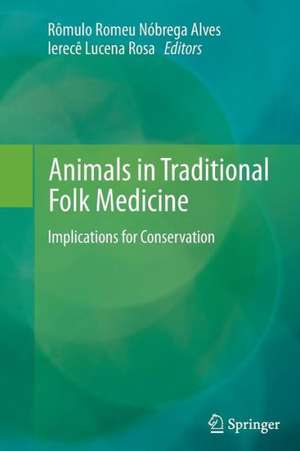Animals in Traditional Folk Medicine: Implications for Conservation
Editat de Rômulo Romeu Nóbrega Alves, Ierecê Lucena Rosaen Limba Engleză Paperback – 15 oct 2014
| Toate formatele și edițiile | Preț | Express |
|---|---|---|
| Paperback (1) | 954.45 lei 6-8 săpt. | |
| Springer Berlin, Heidelberg – 15 oct 2014 | 954.45 lei 6-8 săpt. | |
| Hardback (1) | 956.81 lei 6-8 săpt. | |
| Springer Berlin, Heidelberg – 19 sep 2012 | 956.81 lei 6-8 săpt. |
Preț: 954.45 lei
Preț vechi: 1163.97 lei
-18% Nou
Puncte Express: 1432
Preț estimativ în valută:
182.69€ • 198.51$ • 153.56£
182.69€ • 198.51$ • 153.56£
Carte tipărită la comandă
Livrare economică 21 aprilie-05 mai
Preluare comenzi: 021 569.72.76
Specificații
ISBN-13: 9783642445422
ISBN-10: 364244542X
Pagini: 508
Ilustrații: XVI, 492 p.
Dimensiuni: 155 x 235 x 27 mm
Greutate: 0.7 kg
Ediția:2013
Editura: Springer Berlin, Heidelberg
Colecția Springer
Locul publicării:Berlin, Heidelberg, Germany
ISBN-10: 364244542X
Pagini: 508
Ilustrații: XVI, 492 p.
Dimensiuni: 155 x 235 x 27 mm
Greutate: 0.7 kg
Ediția:2013
Editura: Springer Berlin, Heidelberg
Colecția Springer
Locul publicării:Berlin, Heidelberg, Germany
Public țintă
ResearchCuprins
Introduction – Toward a Plural Approach to the Study of Medicinal Animals.- From Past to Present: Medicinal Animals in a Historical Perspective.- Medicine From the Wild: An Overview of the Use and Trade of Animal Products in Traditional Medicines.- Medicinal Animals in Ethnoveterinary Practices: A World Overview.- Animals as a Source of Drugs: Bioprospecting and Biodiversity Conservation.- Fish Folk Medicine of Caiçara (Atlantic Coastal Forest) and Caboclo (Amazon Forest) Communities.- Herpetofauna Used in Traditional Folk Medicine: Conservation Implications.- Primates in Traditional Folk Medicine: World Overview.- A Global Overview of Carnivorous Used in Traditional Medicines Implications.- Seahorses in Traditional Medicines: A Global Overview.- Aquatic Mammals Used in Traditional Folk Medicine: A Global Analysis.- Marine Invertebrates in Traditional Medicines.- The Role of Animal-Derived Remedies as Complementary Medicine in Brazil.- Mediterranean Zootherapy: A Historical to Modern Perspective.- A Review of Fauna Used in Zootherapeutic Remedies in Portugal: Historical Origins, Current Uses and Implications for Conservation.- Zootherapy and Biodiversity Conservation in Nigeria.- Wild Mammals Trade for Zootherapeutic and Mythic Purposes in Benin (West Africa): Capitalizing Species Involved, Provision Sources and Implications for Conservation.- Birds of a Feather: Quantitative Assessments of the Diversity and Levels of Threat to Birds Used in African Traditional Medicine.- Animals Traded for Traditional Medicine at the Faraday Market in South Africa: Species Diversity and Conservation Implications.- Finely Ground-Hornbill: The Sale of Bucorvus Cafer in a Traditional Medicine Market in Bulawayo, Zimbabwe.A World Overview.- Animals as a Source of Drugs: Bioprospecting and Biodiversity Conservation.- Fish Folk Medicine of Caiçara (Atlantic Coastal Forest) and Caboclo (Amazon Forest) Communities.- Herpetofauna Used in Traditional Folk Medicine: ConservationImplications.- Primates in Traditional Folk Medicine: World Overview.- A Global Overview of Carnivorous Used in Traditional Medicines Implications.- Seahorses in Traditional Medicines: A Global Overview.- Aquatic Mammals Used in Traditional Folk Medicine: A Global Analysis.- Marine Invertebrates in Traditional Medicines.- The Role of Animal-Derived Remedies as Complementary Medicine in Brazil.- Mediterranean Zootherapy: A Historical to Modern Perspective.- A Review of Fauna Used in Zootherapeutic Remedies in Portugal: Historical Origins, Current Uses and Implications for Conservation.- Zootherapy and Biodiversity Conservation in Nigeria.- Wild Mammals Trade for Zootherapeutic and Mythic Purposes in Benin (West Africa): Capitalizing Species Involved, Provision Sources and Implications for Conservation.- Birds of a Feather: Quantitative Assessments of the Diversity and Levels of Threat to Birds Used in African Traditional Medicine.- Animals Traded for Traditional Medicine at the Faraday Market in South Africa: Species Diversity and Conservation Implications.- Finely Ground-Hornbill: The Sale of Bucorvus Cafer in a Traditional Medicine Market in Bulawayo, Zimbabwe.
Textul de pe ultima copertă
People have relied on medicinal products derived from natural sources for millennia, and animals have long been an important part of that repertoire; nearly all cultures, from ancient times to the present, have used animals as a source of medicine. Ingredients derived from wild animals are not only widely used in traditional remedies, but are also increasingly valued as raw materials in the preparation of modern medicines. Regrettably, the unsustainable use of plants and animals in traditional medicine is recognized as a threat to wildlife conservation, as a result of which discussions concerning the links between traditional medicine and biodiversity are becoming increasingly imperative, particularly in view of the fact that folk medicine is the primary source of health care for 80% of the world’s population. This book discusses the role of animals in traditional folk medicine and its meaning for wildlife conservation. We hope to further stimulate further discussions about the use of biodiversity and its implications for wildlife conservation strategies.
Caracteristici
First book of its kind adding a new dimension to the conservation and utilization of medicinal animals Provides a compilation of current articles discussing key issues on the use of animal products, their trade and conservation Highlights the importance of inter- and cross-disciplinary approaches to increase our comprehension of the interfaces between traditional medicines and the conservation of biodiversity and ecosystem processes Includes supplementary material: sn.pub/extras














